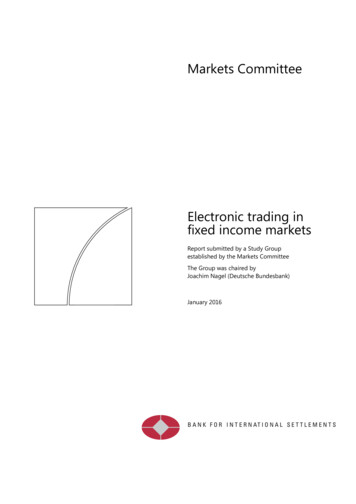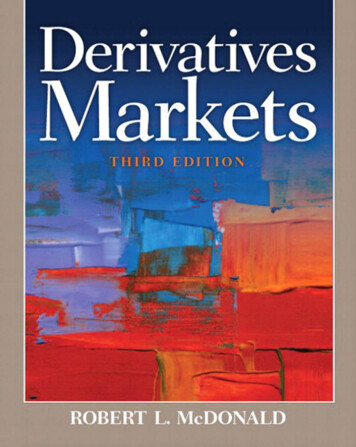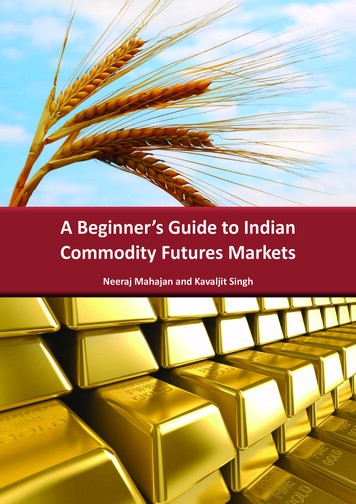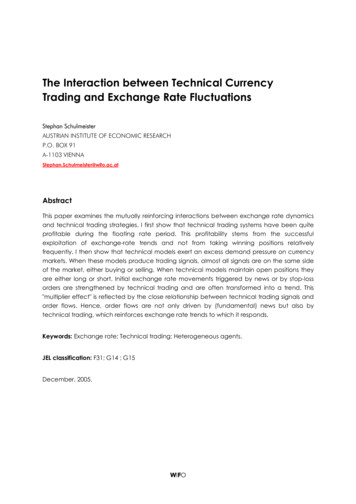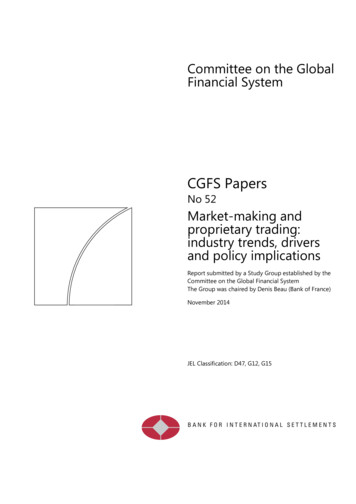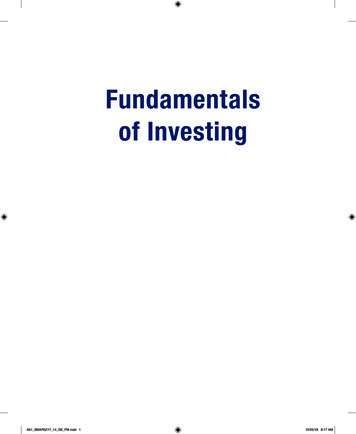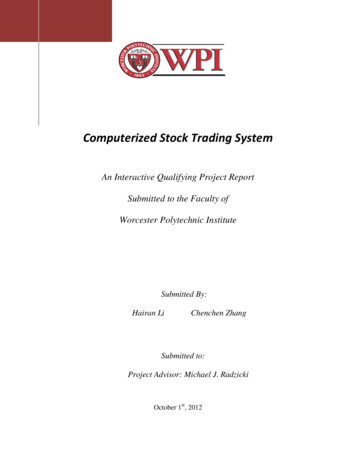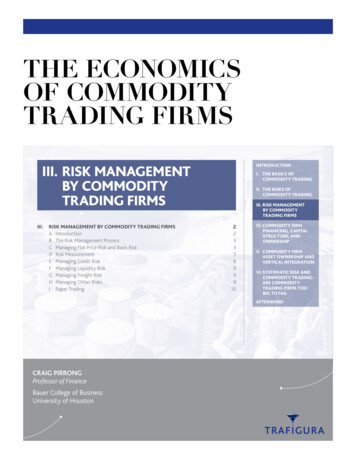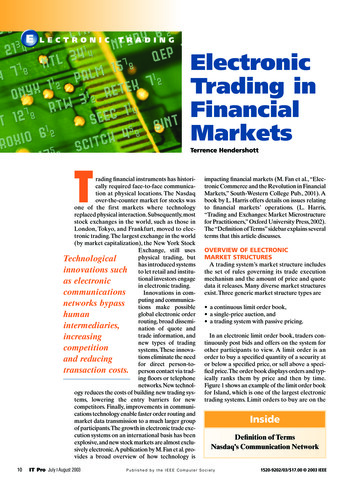
Transcription
ElectronicTrading inFinancialMarketsTerrence HendershottTrading financial instruments has historically required face-to-face communication at physical locations. The Nasdaqover-the-counter market for stocks wasone of the first markets where technologyreplaced physical interaction. Subsequently, moststock exchanges in the world, such as those inLondon, Tokyo, and Frankfurt, moved to electronic trading. The largest exchange in the world(by market capitalization), the New York StockExchange, still usesphysical trading, butTechnologicalhas introduced systemsinnovations such to let retail and institutional investors engageas electronicin electronic trading.communicationsInnovations in computing and communicanetworks bypasstions make possibleglobal electronic orderhumanrouting, broad dissemiintermediaries,nation of quote andtrade information, andincreasingnew types of tradingcompetitionsystems. These innovations eliminate the needand reducingfor direct person-totransaction costs. person contact via trading floors or telephonenetworks. New technology reduces the costs of building new trading systems, lowering the entry barriers for newcompetitors. Finally, improvements in communications technology enable faster order routing andmarket data transmission to a much larger groupof participants.The growth in electronic trade execution systems on an international basis has beenexplosive, and new stock markets are almost exclusively electronic.A publication by M. Fan et al. provides a broad overview of how technology is10IT Pro July August 2003impacting financial markets (M. Fan et al., “Electronic Commerce and the Revolution in FinancialMarkets,” South-Western College Pub., 2001). Abook by L. Harris offers details on issues relatingto financial markets’ operations. (L. Harris,“Trading and Exchanges: Market Microstructurefor Practitioners,” Oxford University Press, 2002).The “Definition of Terms” sidebar explains severalterms that this article discusses.OVERVIEW OF ELECTRONICMARKET STRUCTURESA trading system’s market structure includesthe set of rules governing its trade executionmechanism and the amount of price and quotedata it releases. Many diverse market structuresexist. Three generic market structure types are a continuous limit order book, a single-price auction, and a trading system with passive pricing.In an electronic limit order book, traders continuously post bids and offers on the system forother participants to view. A limit order is anorder to buy a specified quantity of a security ator below a specified price, or sell above a specified price.The order book displays orders and typically ranks them by price and then by time.Figure 1 shows an example of the limit order bookfor Island, which is one of the largest electronictrading systems. Limit orders to buy are on theInsideDefinition of TermsNasdaq’s Communication NetworkPublished by the IEEE Computer Society1520-9202/03/ 17.00 2003 IEEE
left side, and orders to sell are onthe right, with each order’s priceand quantity displayed. The orderbook lists buy orders by descendto market participants.A financial market is aing price and sell orders by ascendOrder routing is the actcommunications systeming price, with orders at each priceof sending orders fromfacilitating transmissionhighlighted in a different color.Thetheir originators, primaof pre- and post-tradehighest-price bid is 24.05, and therily investors and brokerinformation, order routlowest-price offer is 24.06, meandealers, to the executioning, matching, execution,ing the spread between the bestsystem.trade clearing, settlement,buy and sell prices is 1 cent. ForOrder matching andand custody.each security, the top 15 orders onexecution is a transactionA trading system’s proeach side of the book are continugramming instantiates specific rules algorithm that translates orders intoously available on Island’s Web siteregarding allowable messages that trades, which consist of transaction(http:// www.island.com).participants can send and receive and prices and quantities.A limit order book does not typClearing and settlement is thethe type of information displayed.ically display the user’s identity, theThe system transmits pre- and post- process of exchanging the seller’sorder’s entry time, or the period fortrade data about quotes and trades shares for the buyer’s cash.which the order is good. A participant either initiates a trade with anorder already on the order book orplaces a new limit order in the book. If a bid or offer is inthe book and a participant enters an order on the otherFigure 1. Island’s limit order book.side of the market at the same price or better, the limitrefresh island home disclaimer helporder book automatically and immediately matches theorders, and a trade occurs. The book can match incomingGET STOCKorders against more than one existing order.In a single-price auction system, participants may subMSFTgomit bids and offers over a period of time, but the systemexecutes all trades together at one price, at a single pointSYMBOL SEARCHof time. The system normally calculates the transactionLAST MATCHTODAY’S ACTIVITYprice to maximize the total volume traded, given the bidsPrice24.0510 Orders37,864and offers residing in the system. Bids and offers withTime 13:15:23.745 Volume 6,972,147prices at least as good as the system-calculated price areprocessed into trades, subject to a set of priority rules.ThisBUY ORDERSSELL ORDERSstructure has variations, depending on order type andSHARESPRICESHARESPRICEorder information display.1,00024.05005,00024.0600Some electronic trading systems determine trade prices10024.05002,00024.0700by explicitly referring to other markets’ pricing and sales2,10024.03204,00024.0700activity. We refer to such trading systems, which have no2,65024.024050024.0770independent price discovery mechanism and whose prices2,50024.024030024.0780are taken directly from a primary market, as passive or1,00024.022070024.0790derivative pricing systems. Some systems allow for the pos4,50024.02101,00024.0800sibility of price improvement by assessing market condi2,00024.02002,60024.0900tions in the underlying market and then pricing their tradesat a price better than the best quote on the underlying mar2,50024.02003,00024.0900ket available at the time of the order entry. Prices may vary30024.01002,00024.0900through the trading session—if the system operates at the1,00024.10001,00024.0900same time as its associated primary market—or may be20024.100075024.0900fixed at a single level, such as the closing price for an after20024.10001,20024.0990hours trading session. A system may base trade execution4524.10005,40024.0990on different secondary priorities than those present in the6,00024.100010024.1000primary market. The brokerage and trading services com(498more)(587more)pany ITG operates the largest passive pricing system—called POSIT—which traded 7.7 billion shares in 2002 andDefinition of TermsJuly August 2003 IT Pro11
ELECTRONICTRADINGhas been growing at an annual rate of about 50 percent.POSIT prices its trades at the midpoint of the bid/offerspread (the difference between the lowest asking price bya seller and the highest bid from a buyer) in the stock’s primary market at the moment the match is run. Eight timesdaily—at 9:40 a.m., 10 a.m., and 10:30 a.m., and on the hourfrom 11 a.m. to 3 p.m.—POSIT compares and matches allbuy and sell orders confidentially. If an imbalance existsbetween buy and sell orders, the system randomly selectsorders on the excess side to match the number of orders onthe smaller side. Orders that the system does not select donot execute.THE GROWTH OF ELECTRONICCOMMUNICATIONS NETWORKSThe Securities and Exchange Commission (SEC) definesthe biggest electronic trading systems, electronic communications networks (ECNs),as “electronic trading systems thatautomatically match buy and sell orders at specified prices”(http://www.sec.gov/answers/ecn.htm). The SEC describesECNs as integral to the modern securities markets, and inAugust 2002 ECNs accounted for approximately 40 percentof volume in Nasdaq securities. The most common ECNstructure is similar to the electronic limit order book dis-WE POWER THE BEST BUSINESSES.AND THE BEST MINDS.At SAP Labs, we design and implementinnovative business software that helpsmillions around the world. And it’s people likeyou that make it all possible. That’s why SAPcelebrates the individual – striving to let everyidea and every voice be heard. And throughthe collaboration of these ideas, we’reempowering the best minds to help powerthe best businesses. In return for your efforts,we offer one of the most competitive benefitspackages in the industry including three weekspaid vacation, premium health coverage, lifeinsurance, flex hours, and even subsidizedlunches. Visit www.saplabs.com to learn moreand find out where you fit in.EOE12IT Pro July August 2003cussed earlier. Several ECNs are currently registered in theNASDAQ system: Attain, Archipelago, Brass Utility,Bloomberg Tradebook,Instinet,Island,NexTrade,and Track.ECNs’ automated communication and matching systemshave led to lower trading costs. By matching buyers andsellers directly, ECNs bypass human intermediaries such asdealers, reducing their profits. Dealers on the New YorkStock Exchange and the Nasdaq have average operatingmargins of approximately 50 percent and 25 percent,respectively. ECNs offer other traders the opportunity toundercut these margins, increasing competition and reducing transaction costs.ECNs also offer faster trade execution.Their leading-edgetechnology allows significantly faster order execution thanestablished market centers’ trading systems.For example,theaverage execution time for an ECN is two to three seconds,compared with more than 20 seconds for an order throughan exchange.Furthermore,ECNs typically provide investorswith more complete price information than traditional market centers by allowing them to see the ECN’s limit orderbooks.This information allows investors to better assess market conditions and optimize their trading strategy.By displaying only the price and size of an order, ECNsprovide trader anonymity.Anonymity is potentially important for informed institutional investors, because lessinformed traders may attempt to copy their strategy. Inaddition, if other market participants can obtain prior orcontemporaneous knowledge of transactions, they mayattempt to trade before the institutional investors can complete their trades, a practice known as front running. Infinancial markets, any sort of front running or informationleakage is a serious concern.ECNs offer brokers and their customers access to theirlimit order book. Typically, ECNs first attempt to matchcustomer limit orders within the ECN. When ECNs findan internal match, the trade executes immediately. Someof the larger ECNs such as Instinet and Island match morethan 70 percent of their order volume internally. Whenthey do not find internal matches, ECNs offer subscribersseveral options. The subscriber can leave the limit orderon the ECN’s book, cancel the order, or route the order toanother ECN or market.ECNs compete with each other by targeting differentclienteles and following various strategies. Some ECNs suchas Island use only limit orders and are destination-onlyECNs, meaning orders do not leave the ECNs until they arecanceled, regardless of whether or not they could executesomewhere else. If a match is not found, the ECN posts theorder on the Nasdaq as soon as it becomes the ECN’s bestquote, and waits for an incoming order to trade at its price.Other ECNs take market orders (orders to buy or sell astock immediately at whatever is currently the best available price) and limit orders and, if an internal match is notavailable, route them to the Nasdaq in search of the optimal price.These outbound-routing ECNs actively seek out-
Nasdaq’s Communication NetworkSuperMontage increases transparency across Nasdaq,provides new order entry tools to facilitate complex trading strategies, and improves Nasdaq’s order execution.The SuperMontage display in Figure A lists each market participant by moniker with its best bid and ask priceand then the number of hundreds of shares available atthose prices; the columns on the left are sorted by bidprice, and the columns on the right by ask price.SuperMontage includes the traditional information provided by Nasdaq of the best price by market participant,but also allows participants to post orders at three prices.Market participants can also post orders anonymouslywith these orders. They are aggregated together andlisted under the “SIZE” moniker. SuperMontage alsoallows traders to directly factor ECNs into their orderrouting decisions.Although SuperMontage is a large step forward forNasdaq and lets users trade directly with one anothermore quickly than before, it does not offer all of the functionality that ECNs do. SuperMontage does not alloworders to be conditional upon one another—for example, having one order cancel if another executes.SuperMontage does not allow direct negotiationbetween traders. Also, SuperMontage does not provideside liquidity. If the national best bid or offer, the best priceavailable across all markets, is from another market, an outbound-routing ECN sends its orders there. Interestingly,outbound-routing ECNs are some of the best customers ofdestination-only ECNs.ECNs differentiate themselves in other ways. Outboundrouting ECNs employ proprietary methods/algorithms toselect the market center that is likely to provide the bestcombination of speed, quality, price, and certainty of execution for its customers. Other ECNs batch orders for shortperiods and conduct regular “call markets” to establish astock price, as described earlier in the single-price auctionsystem. ECNs also vary in the manner and type of information they provide investors, with some posting all orpart of their limit-order books on Internet sites such asIsland, while others provide limited access to price information.These various approaches to price discovery, execution, and information dissemination attract diverseclients with wide-ranging trading needs.For their services, ECNs charge fees that subscribers paydirectly and nonsubscribers pay indirectly. For subscribers,these fees include a fixed component, the cost of purchasing the ECN terminal and line feed, and a per-share feefor execution. ECN subscribers typically submit limitorders without charge, but pay an access fee of 0.1 cent toFigure A. Nasdaq’s SuperMontage.post-trade anonymity for traders. The SIZE monikerallows pretrade anonymity; but, unlike trades on ECNs,the clearing and settlement process for SuperMontagetrades reveals trader identities.2 cents per share for orders that execute against a standing ECN limit order.To encourage depth in the limit orderbook, some ECNs charge a fee if an incoming order immediately executes against the limit order book. In Island’scase, the execution fee is 0.19 cent per executed share; a0.11 cent rebate per executed share is paid if a limit orderdoes not execute immediately and subsequently executesagainst an incoming order.Competition from the ECNs forced Nasdaq to changethe way it operates. Its solution is SuperMontage, which the“Nasdaq’s Communication Network” sidebar describes.SuperMontage and the ongoing innovations by ECNs continually change the competitive environment and have ledto a complex array of competing markets for US equitytrading.Wall Street firms have at times taken ownership inmany of these markets simultaneously.These relationshipsprovide ECNs with capital, order flow, and legitimacy.ELECTRONIC SYSTEMS IN MARKETSOTHER THAN EQUITIESThe foreign exchange (FX) and bond markets providean interesting contrast to stock markets.These have traditionally been dealer markets that operate over the telephone. No physical location exists, and trading is donedirectly by pairs of dealers or with the help of brokers thatJuly August 2003 IT Pro13
ELECTRONICTRADINGintermediate between them. In recent years, portions of compared with systems relying on human intermediation.However, for large transactions, many institutions avoidthe foreign exchange market rapidly moved to electronictrading. In contrast, the bond market has been slow to exchanges completely by using the “upstairs market” forinstitutions trading with one another.This trading of largechange and is still largely a telephone market.The enormous volume of foreign exchange— 1.5 tril- blocks typically occurs without formally posting limitlion a day—has traditionally been a multiple-dealer mar- orders, which is the heart of most electronic trading sysket. In such a market, trade transparency is low and a large tems. Instead, institutions do not reveal orders until a partyamount of trading volume and trades between dealers willing to take the opposite side of the transaction is availaccount for close to two-thirds of the activity. Historically, able for a large trade. It is possible that these types oftraders dominate trading in partsthis activity was telephone based.the FX market and the bondThen Reuters and EBS developedUntil electronic trading ofmarket. Electronic systems havetwo major electronic systems fortried to develop approaches toproviding quotes. Initially, tradessystems can replicateautomate these more difficultwere still conducted over the teleall the functions of atrades, but unless these can be perphone. Not surprisingly, these sysfected, the adoption of electronictems later developed into fullfloor-based system and trading systems by existing martrading platforms, allowing trademight result in additional tradexecution. In 1995, 25 percent ofhuman intermediaries, ketsing moving off-exchange.Althoughtrading was conducted electronitechnological trends favor thecally. By 1998, this had risen to 50a role remains foradoption of electronic trading syspercent, and it is expected to confloor-based trading.tems and these systems have madetinue rising. Although FX tradinggreat inroads in several markets,between dealers has largelyuntil they can replicate all the funcbecomeelectronic,tradingbetween large corporations and dealers remains telephone tions of a floor-based system and human intermediaries,based. Several electronic platforms now disseminate such as dealers, market makers, and specialists, a rolequotes and allow trading, but their volume is not yet sub- remains for floor-based trading.As technology and ECNs continue to grow and transstantial.The interdealer market’s move toward electronictrading, coupled with the corporate market’s continued form securities trading, many issues warrant further explouse of telephone-based trading provides an interesting ration. When are electronic markets the most useful involatile markets? What types of traders use ECNs—moredichotomy.Traditionally, the structure of bond markets has been informed institutions or retail investors? Are traders willsimilar to that of foreign exchange markets, with second- ing to pay more for the speed and anonymity that ECNsary trading in government, municipal, and corporate bond provide? How does ECN activity impact existing marketsmarkets occurring over the telephone with multiple deal- in terms of volatility, trading costs, and market depth? Willers. US Treasury securities trading is around 200 billion these systems enable the full development and adoption ofper day. In contrast to the FX market, the move toward 24-hour global electronic markets? electronic trading has been relatively slow. In 2000, about40 percent of US Treasury securities were traded electronically and only 10 percent of corporate bonds weretraded electronically.This is not due to a lack of electronicbond-trading platforms: There were 11 electronic tradingsystems in 1997, 40 in 1999, and more than 80 by 2000.ARE ELECTRONIC MARKETS INEVITABLE?Although ECNs have come to play a very important rolein equity trading, the FX and bond markets suggest thatelectronic trading might not be preferable for all investors,types of securities, and market environments. The adoption of electronic information dissemination and execution can reduce the costs of order execution significantlycompared to traditional physical exchanges. These reductions come through lower development and operatingcosts, as well as important liquidity advantages arising fromthe greater transparency of electronic trading systems14IT Pro July August 2003Terrence Hendershott is an assistant professor of operations and IT management for the Haas School of Business,University of California at Berkeley. Contact him athender@haas.berkeley.edu.For more information on this or any other computing topic,visit our Digital Library at http://computer.org/publications/dlib.
of participants.The growth in electronic trade exe-cution systems on an international basis has been explosive,and new stock markets are almost exclu-sively electronic.A publication by M.Fan et al.pro-vides a broad overview of how technology is impacting financial markets (M. Fan et

